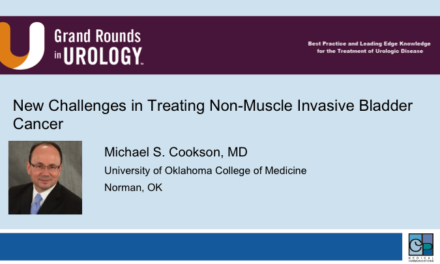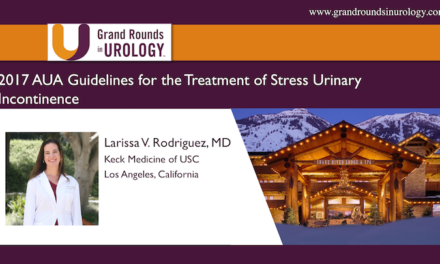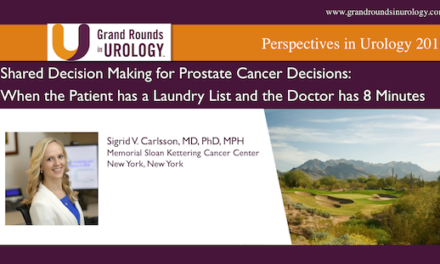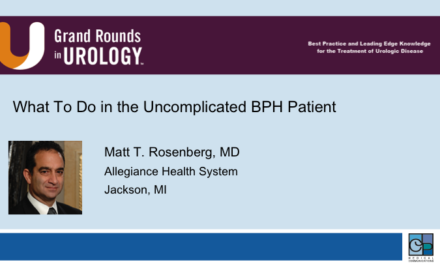Dr. Ryan P. Terlecki presented “Sexual and Urinary Health After Treatment for Prostate Cancer” at the 26th Annual Perspectives in Urology: Point-Counterpoint, November 10, 2017 in Scottsdale, AZ
How to cite: Terlecki, Ryan P. “Sexual and Urinary Health After Treatment for Prostate Cancer” November 10, 2017. Accessed Jan 2025. https://dev.grandroundsinurology.com/sexual-urinary-health-treatment-prostate-cancer
Summary:
Dr. Ryan P. Terlecki, MD, FACS, discusses urinary control following prostate cancer surgery and following radiation therapy, the outcomes of anti-incontinence surgery and the impact of radiation therapy, the current state of the art of penile rehabilitation after radical prostatectomy and the evidence or lack thereof for different strategies.
Sexual and Urinary Health After Treatment for Prostate Cancer
Transcript:
So I was asked to think about urinary and sexual health. This is a big part of what I actually do in practice. And so how we work together, meaning when I saw we, I mean those of you that treat prostate cancer and those of us that try to focus on some of the things that go along with that. And I’ll talk more about survivorship later in the course of this meeting.
So in 20 minutes I’m going to go on the data as it relates to urinary control following surgery and following radiation; discuss the outcomes of anti-incontinence surgery and the impact of radiation therapy define penile rehab to an extent if possible; and to discuss the current state of the art of penile rehabilitation after radical prostatectomy and the evidence or lack thereof for different strategies.
Audience response question. Accessory pudendal arteries are the major inflow to the penis in approximately what percentage of men? 10%; 30%, 50%, 70%, or 90.
Okay, number one answer was B, 30%.
Which of the following agents used in penile rehabilitation causes intracavernosal fibrosis? Papaverine; Phentolamine; Atropine; Alprostadil; or Vardenafil.
Okay, most, the highest answer was Papaverine, but there are answers across the board.
Post-prostatectomy incontinence. Published studies on risk mostly involve retrospective data, and there are variable definitions as to what constitutes incontinence. Typically doesn’t involve urodynamics data but that’s for good reason, we talked about that earlier today. Reported rates vary from less than 10% to as high as 80%, but about 20% use pads after surgery in long term.
There’s no difference between open and robotic in a prospective trial and there was a meta-analysis of retrospective studies suggesting a benefit with robotic approach. I do think that we see less men for severe incontinence in the robotic, I do believe that. I just want you to know that when I see these men in practice, I never refer to this as a complication of radical prostatectomy. If you do the operation in the same way every time, different patients heal differently. And it’s all on a spectrum. Same thing with their sexual function. There was a Prostate Cancer Outcomes Study, nearly 1,300 men after surgery. At 18 months follow-up 8.4% were incontinent, but only 31.9% had total urinary control. So you can see how the definitions can change the numbers. Similarly, 65.6% had self-reported incontinence in another study.
What are the trends in repair? Well we looked at this nationally. Thirty-two thousand procedures for male incontinence were performed over 12 years; 20.790 artificial sphincters; 11,625 slings. There was a significant decrease in the total number of procedures done, so less men are getting surgery for incontinence despite a relatively stable rate if radical prostatectomy during that time span.
But when stratifying data by the type of the anti-incontinence surgery, sphincters were going significantly down and slings going significantly up.
Now does this say for certain that we’re seeing lesser degrees? Not for certain, there are other things that could be possible, so it could be that the sling is patient driven. We already know that given the option, patients like the idea of a sling better than a sphincter because they don’t have to cycle a device. It could also be that surgeons are becoming more comfortable doing slings and using them to a greater degree to treat higher levels of stress incontinence, and it may be coming more risk averse to doing a sphincter.
What’s the impact of radiation? Well one in three patients will require adjuvant or salvage radiation at some point after surgery. Adjuvant IMRT has been shown to have late incontinence rate of 18% and a stricture rate of 6%. Adjuvant radiation has more than two times worse incontinence than wait-and-see approach and that was based on the SWOG study.
It’s important to consider when long-term follow-up of an EORTC trial has shown that clinical progression-free survival previously reported with adjuvant radiation no longer significant. In patients over 70, adjuvant radiation had detrimental effect on progression-free survival and overall survival. Continence may improve for one to two years after surgery which blurs data on the overall impact of radiation. And there’s also issue of pathologic continence. What do I mean by pathologic continence? So if any of you have ever worked in the VA, you might be taking a guy for a penile implant. Maybe you’re a resident. And being the case you’ve got to place that catheter and you can’t get it in because they had a contracture you didn’t know about. And so maybe you thought maybe it’s okay, I’ll just dilate the contracture and go ahead with the operations so I can have a catheter for safety. And then when the guy has a catheter taken out, he starts to leak and he’s wondering what you did to him. So that’s why I refer to it as pathologic incontinence. Timing less than six months, or greater than six months, how far out you are from the radiation doesn’t seem to make a significant difference based on retrospective data in terms of the outcomes from anti-incontinence surgery.
A meta-analysis looking at complications after sphincters in patients that had both surgery and radiation, saw that the revision rates significantly higher if they get radiation, and persistent incontinence is significantly higher. So it’s not the best thing for optimal outcomes. It doesn’t mean it’s not worth doing a sphincter, but they’re not going to do as well as if they never had radiation. The risk of erosion is higher, and the overall success ate with AUS does drop in irradiated patients looking at 89% if they haven’t been radiated to 56%.
What about slings? Some people say you should never put a sling in a radiated patient. I wouldn’t say never. One of the words you learned to not use, never and always, but advance sling success is about 545 overall in the radiated patients, versus 75% if you include radiated and non-irradiated.
There’s an ongoing trial called the MASTER trial, and that data will be available eventually, and this is being done in the UK. And so they’re comparing the sling versus the sphincter, multicenter after prostate cancer surgery. Right after prostate surgery whether cancer or benign. Any age, any level of incontinence, no exclusion for radiation, and they want to randomize 360 and follow another 360 but it’s only slated for two year follow-up.
What about ED? Erectile Dysfunction after radical prostatectomy is as high as 90% in some series, but more recent data suggests it’s probably around 68%. It’s still the most common long-term side effect after radical prostatectomy. I don’t think that this necessarily should be attributed to the surgery in all cases. I find that a lot of men don’t have a preexisting diagnosis of ED on their record because it hasn’t gotten bad enough to seek treatment or nobody asked them. They get diagnosed with prostate cancer, the come back, and now people are asking what about your erections. Well, they probably had some degree of ED already based on what we know about statistics, and I told you those earlier from the aging studies done in Massachusetts.
But we will see those patients. You mentioned a support groups being a problem, and I agree, I think physicians should oversee a lot of these men to men or us two groups. I think if you’re going to have a chapter locally, be involved. Have yourself there, or a representative there. But you will see these men that say they wished they never their prostate surgery. Data shows that men are actually willing to accept a 10% decrease in overall survival to preserve their erectile dysfunction when considering their treatment options, so it’s important. Dry and potent patients rarely have regret from having their prostates out. Preop counseling for the vacuum device, for intracavernosal injection has demonstrated reduced long term postop regret by a factor of 10.
The impact of sexual function is greater than that of incontinence. That surprises me, but I think it’s probably relative to the degree of either condition to tell you the truth. But it does negatively impact quality of life.
And you’ll see those couples. If you’re someone that treats ED in your practice, and you’ll see the wife pat his hand, it’s okay, we have a good relationship.
But intimacy is always important. Now you don’t necessarily need intercourse to have intimacy, but there’s something unique about that type of behavior. And I already told you that there’s always a psychological component even if it’s organic ED from something else, so if you have access to a good counselor, that should be part of your survivorship program. And again we’ll talk about that tomorrow.
Like I tell patients when we’re talking about nerve input, and vascular input, it’s all plumbing and electricity. I try to keep it simple to explain how this works.
What about the plumbing, the arterial protection? There are accessory pudendal arteries above pelvic diaphragm, there are prone to injury during radical prostatectomy. These are the major inflow to penis in 70% of cases and the sole inflow in 10%. Some suggestion of improved erectile function if you are able to preserve these. Major inflow in 70%.
What about the electrical input? The cavernous nerves? Well it’s a poorly visualized plexus and it’s quite variable. It can be injured by a number of ways, traction, transection, traction, thermal. Neural injury leads to fibrosis via TGF-beta 1 and pro-apoptotic factors. Absence of nocturnal tumescence may contribute to hypoxic injury, “use it or lose it” right? So we talk about not having those frequent unconscious erections, what does that mean for patients.
Offering penile rehabilitation, it may seem like a no-brainer, but it’s not free, it’s not always convenient, and there are side effects. And we need to address both form, physically, and function.
What is penile rehabilitation? Well, is it just enabling sexual function after treatment for prostate cancer? Is it restoring natural and spontaneous erections” Is it getting the patient to preop status? We don’t know because it’s not well defined. To say rehab, the concept would be we’ll get you back to where you were, but that’s a moving target because we know that every day that goes by, that man’s a day older. His body is a day different. It’s a different environment. So if you had never operated on him and followed him for the same length of time, his erectile function will be worse anyway.
It’s probably a combination but it’s not the same thing as just giving him ED treatment. So that’s important when you hear people lecturing and supporting penile rehabilitation protocols, that’s not the same thing as trying to prescribe something so that they can still have that degree of physical intimacy.
What’s the quality of evidence to support penile rehab? It’s lousy. It’s a lot of junk science. Small numbers, not randomized, not blinded, lack of consensus.
We talk about a number of neurotrophic agents, what we could use down the road, perhaps encourage production of. PDE5 inhibitors appear to be most promising.
And there’s a value in induction of nitric oxide synthase to protect from some of these detrimental changes. It’s been shown to reduce cardiac necrosis and in animal model of ischemia and reperfusion.
For the small percentage of those undergoing non-nerve-sparing radical prostatectomy, the benefits we’re still seeing. And the speculation was that non-neuronal stimulation of nitric oxide production via endothelial nitric oxide synthase was of value. There’s a lot of data in animal models suggesting yeah, this makes sense. But clinically it hasn’t really panned out and that’s unfortunate.
If you remember this classic Seinfeld episode, right? So she walks in on George. George is saying oh it’s not normally this small, it’s shrinkage.
Men talk about loss of length. And so once study found that 71% of radical prostatectomy patients had a loss of length, a stretch penile length anywhere from 0.5 to 4.0 centimeters by three months postop. And half of the patients lost at least 1 cm. Another study found that about two-thirds had shortening. The average loss of length was about 9%. Length preservation and recovery of erectile function seem to go hand in hand. Some studies though have shown that this tends to recover with time, if you give men time to observe.
There’s a randomized study, 94 patients after a robot prostatectomy, 11 months follow-up. There were standardized to receive Muse which I never really prescribed, men tend to hate it, or Viagra nightly. And one month postop there was an average loss of 0.647 cm, but there seem to be recovery by nine months in those patients that had recovery of function.
As far as preserving length, there has been randomized to no treatment or to get Cialis at different intervals. Preop length and circumference were measured both in the flaccid and when they stimulated erection. And there was no significant difference between groups in their potency but tadalafil did seem to preserve length so maybe some benefit there.
After five days of daily Cialis, you get steady state on the 5 mg and that’s half of the peak concentration you get on the on-demand 20 mg. And the data is mixed regarding of one type of prescribing is better than another. Patients with intermediate risk of ED are shown to have better recovery with daily usage.
Intracavernosal injections. These were part of the reason why penile rehab became so popular based on Montorsi data. But they found that it may possibly encourage an earlier return to spontaneous erection, but again small numbers in that study. Adding sildenafil in addition seems to lessen the penile discomfort, not quite sure why that would be.
Intracavernosal injections have been around since ’83. You have single agent, and you have multiple agents. I find that Trimix tends to be one of the most common that’s given out in practice. It’s a little bit cheaper.
Stable for six months if frozen, one month if refrigerated, and three weeks at room temperature. It offers less pain than the alprostadil which is PGE1 given by itself. That’s Edex and Caverject and that’s what causes the burning. So the papverine which is included within Trimix, the vasodilator, that’s what causes fibrosis. Papaverine causes fibrosis. Phentolamine is an alpha blocker.
Again, I mentioned Montorsi’s data. This goes back to ’97 and this was what really started this wave of considering men for intracavernosal injections. After nerve-sparing prostatectomy, and there was a significant difference in the spontaneous erection rate. But there were only 12 patients, no long term follow-up, and nobody has duplicated this data.
John Mulhall, 2005, said it seemed to help but it was retrospective and non-randomized.
Another study looking at Larry Levine’s group, 2008, multicenter. Four weeks postop, they got 36 weeks of nightly Viagra or placebo and eight week washout. Then they looked at nocturnal penile tumescence testing which I told you we don’t even really do so much anymore. It was stopped early for presumed lack of efficacy, but the percentages looked pretty different to me. So it suggested that maybe there’s a window of opportunity but again, no conclusive data on that.
There was another multicenter trial called REINVENT, so two weeks after surgery patients were randomized to one of three groups for nine months. They got Levitra nightly, and placebo on demand. They got flex dose where they could titrate or they got nightly placebo or placebo on demand and then they had a washout. And on-demand therapy appeared to work better than nightly, but all the benefits were gone after the washout period. So the question is, have you helped them recover or are we just helping them when you’re giving them the medication. It doesn’t look like you’ve helped their overall recovery.
As I mentioned, the function’s changing with time, so it’s a moving target. You have social and psychological components, so when a guy is dealing with certain things, whether it’s his cancer diagnoses, whether it’s his urinary control, whether it’s his erectile function, this is all affecting his psychological state and that can wreak havoc on his sexual well-being. It’s importance to the partner, especially when you’re criticize–well, I don’t want to say criticizing, I will say critiquing data in the literature, how many of these men had a partner? How many of them had the opportunity to be sexually active? How strong is the relationship, do they have a good adjustment? And there’s a high drop-out rate in a lot of these penile rehab studies, up to 73%, so again the data is not quite there.
The waiting game. Some data suggested function may improve two to four years after surgery. However, after two years many suggest that patients could be considered for a penile implant of they’ve failed all these other conservative forms of therapy.
The vacuum device seems to have been benefited in an animal model looking at changes in the tissue. It does increase the ratio smooth muscle to collagen, seems to reduce apoptosis.
I tell people if you’re going to use it to do without the constriction band. Toby Kohler showed that early use prevented a loss of length. But remember they’re not just stretching the corpora bodies, the glands are being stretch which is contiguous with the urethra and is not part of that tissue. But it’s well tolerated if you’re not using the ring. Once they own it, they own it. They don’t need a prescription anymore. There’s no systemic side effects, it gets them involved in recovery, so maybe there’s some psychological benefits there.
Muse, again seem to work regardless of whether or not there was a nerve-sparing operation. One study showed an increased rate of subsequent natural erections. That might have been Craig Zip’s [phonetic] group. That’s the only guy I’ve ever heard lecture about Muse when I was a resident. He was the only guy that ever traveled and said you should use this.
Gene therapy, we’ve looked at this in my lab at Wake. It’s promising but it’s certainly not ready for prime time.
Tissue engineering, Hunter [phonetic] Wessels was able to place autologous endothelial cells into the corpora so that they can remain viable. Again, an animal model. My boss, Tony Atala was able to use matrices with human cells. And we can now grow patient specific corpora and we should be going live with an engineered corpora study within the next 12 months. We’re already FDA approved for engineered urethras funded by the Department of Defense and approved by the FDA.
So what are my two-cents? We’re waiting to see if patients maintain potency without helping them, it could be detrimental. And regardless of early postoperative erectaids improved subsequent spontaneous erections, early use may help avoid postop depression.
What are recommendations out there? We’ll discuss it preop. Use a validated instrument. There’s no evidence that says you should pick one particular technique. Favorable predictors, the patients are younger, they have good function before and they have bilateral nerve-sparing. But talk to the patients about the pathophysiology, it seems odd to do that but I think it alleviates some of their concerns.
Recover can take years and there’s conflicting data on the value of penile rehab. Men having radical prostatectomy are also at risk for decreased libido, change in orgasm, surprisingly I see guys who come to me who didn’t know that they weren’t going to ejaculate anymore.
Should you throw the kitchen sink at them? Some people suggest you should.
Mulhall who is over at Sloan-Kettering sees a lot of these patients for, who’s the guy, Eastham, who’s a great surgeon. They have a high volume practice. So they do preop counseling and do low dose phosphoresterase inhibitors for a couple of weeks afterwards. Catheter removal, every other night, maxed dose once per week. And if they’re responding, they go to low dose, and then high dose. If they’re not responding, they’re doing injections. It’s a very complicated regimen. I don’t know that’s practical for everybody in practice.
My program, assess their SHIM score beforehand. So I’ll tell there’s value, if you work with guys that don’t do prostatectomy, and you establish an ED diagnosis and use it as a separate diagnosis in the 90 day global after your prostatectomy. Because if they’re seeing them for penile rehab and the billing diagnosis is ED, that’s not the cancer diagnosis, and they can use their 2/4 modifier on that. Encourage them to bring their partner. Vacuum device if reasonable, night doses of the drugs are reasonable, try to encourage some stimulation, getting them involved with their partner, I think it’s good for the relationship. If they have even mild stress incontinence, consider some type of active treatment, maybe pelvic floor PT.
Alright, back to our two questions. Accessory pudendal arteries are the major inflow, not sole, the major inflow to the penis in what percentage of men? Ten percent, 30%, 50%, 70%, or 90?
Seventy is correct. Nice job.
Which of the following agents is responsible for the fibrosis caused from intracavernosal injections?
Good number of you had this right to start with, we’ll see if that number goes up though. Yeah, 100%, fantastic.
In conclusion, stress incontinence threatens quality of life. Surgical trends appear to be changing and radiation is not such a great thing for surgical recovery. Despite robust animal and in-vitro data, there’s still not enough great evidence to make penile rehabilitation the standard of care. It’s not significantly harmful but there is cost associated with this, and more research is needed. Thank you very much.
ABOUT THE AUTHOR
Ryan P. Terlecki, MD, is a reconstructive urologist for Wake Forest Baptist Health, an academic Level 1 trauma center in Winston-Salem, North Carolina. His positions include Vice Chair and Associate Professor of Urology, Director of the Men’s Health Clinic, Director of Medical Student Education, and Fellowship Director for Reconstructive Urology. He is also the President of the North Carolina Urological Association. His publications cover multiple areas of trauma and reconstruction and his research is focused primarily on models of wound healing and regeneration in the lower genitourinary system. Dr. Terlecki completed two separate fellowships in reconstructive surgery following his residency, and is a member of the Society of Genitourinary Reconstructive Surgeons (GURS). Dr. Terlecki’s areas of expertise include urethral stricture disease, male sexual dysfunction, male incontinence, Peyronie’s disease, chronic testicular pain, hypogonadism, and infertility.





